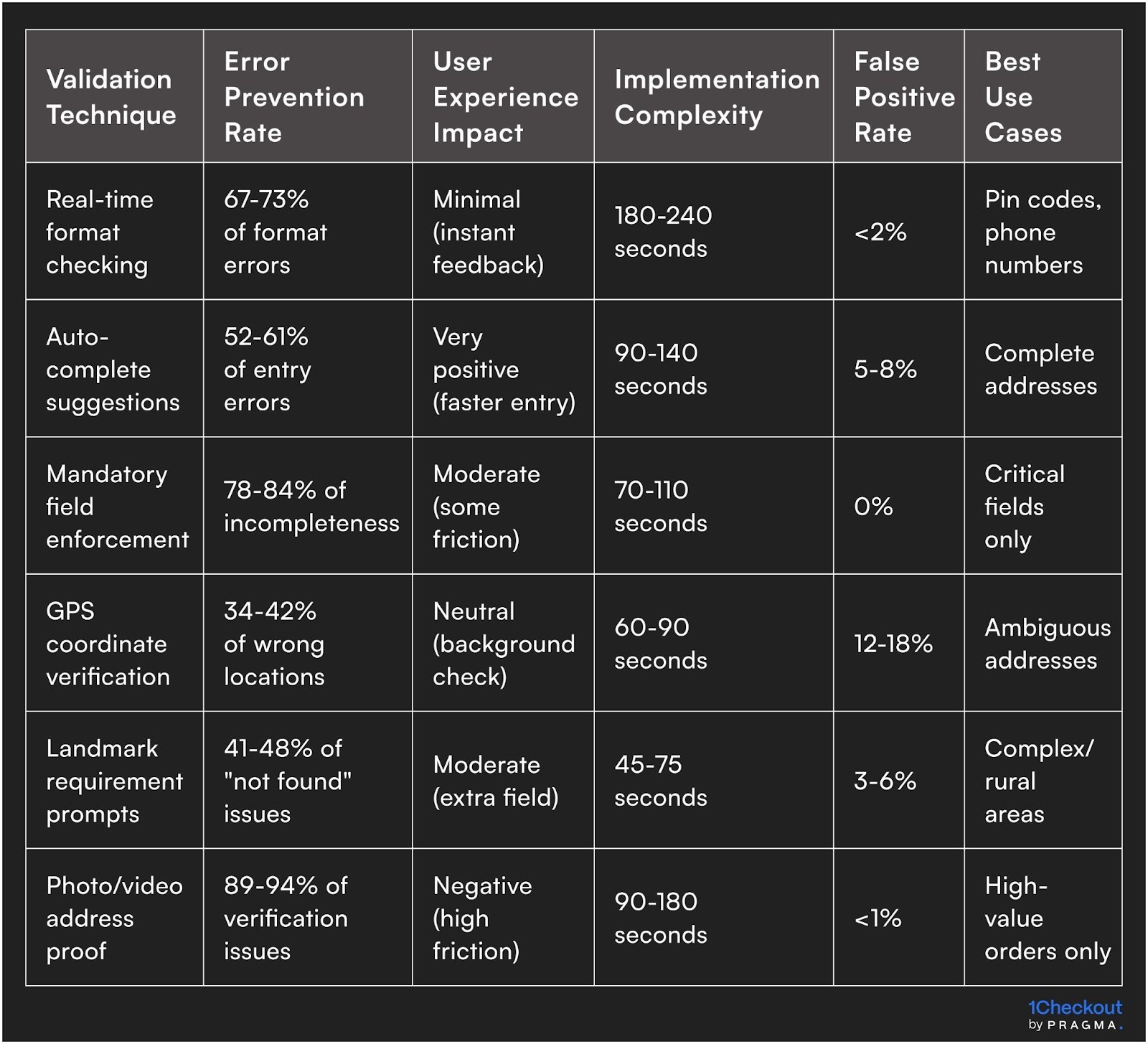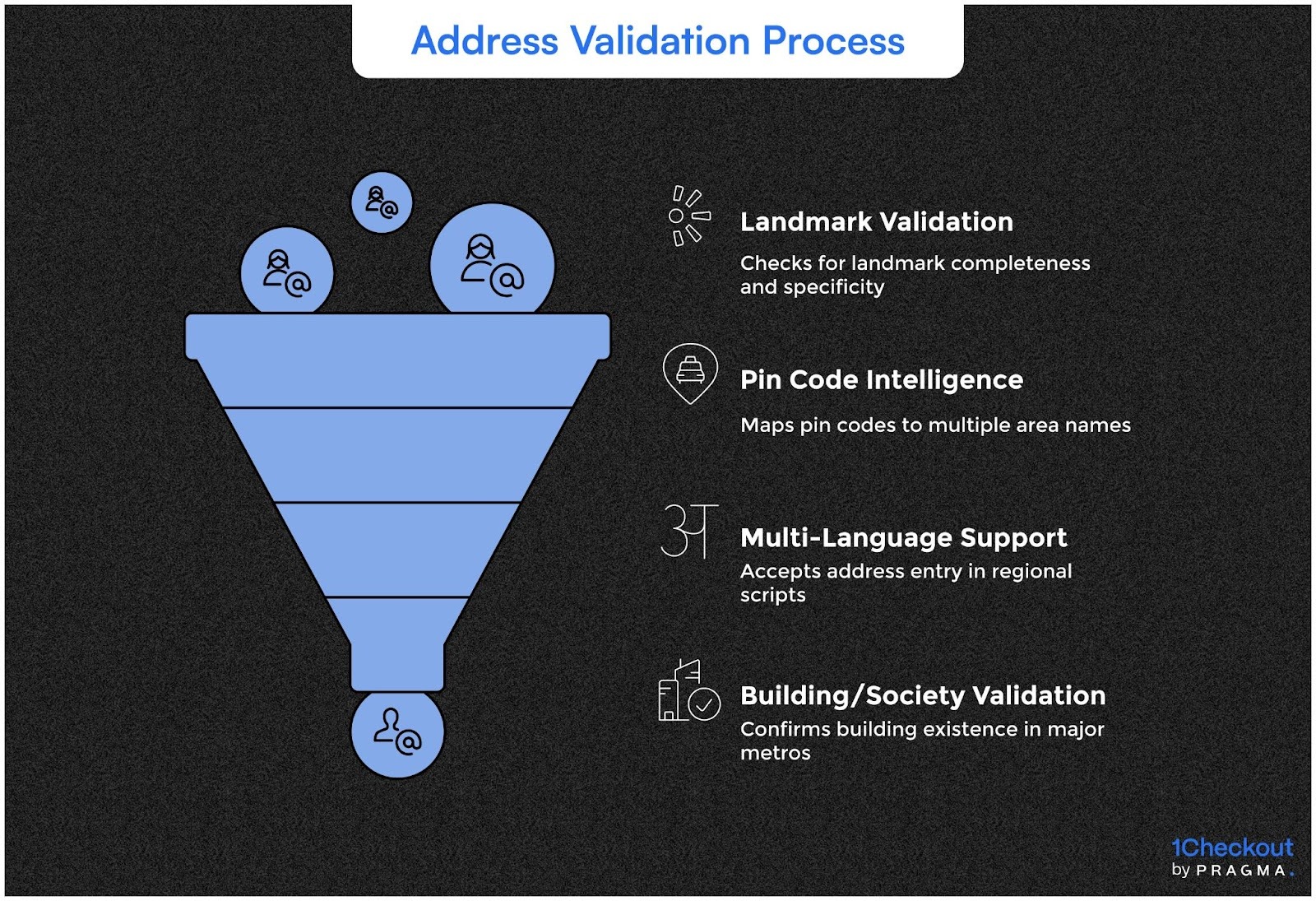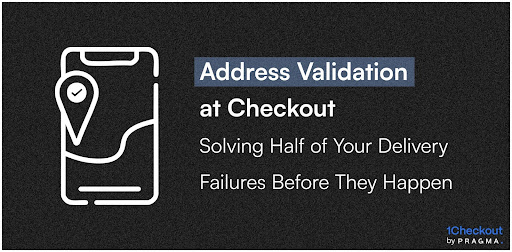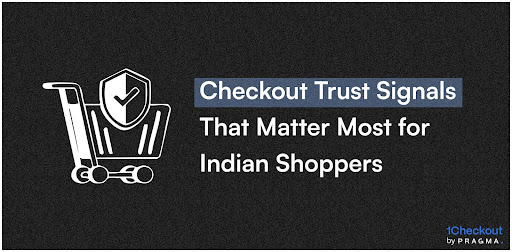Delivery failures are an expensive blind spot — each failed attempt causes not only direct financial losses, but also frustrated customers, support headaches, and a higher risk of Return to Origin (RTO). For most Indian D2C and e-commerce brands, the problem starts right at checkout where a simple typo, missing landmark or non-standard area name turns a confirmed order into a delivery mystery for couriers.
Despite the stakes, address collection still gets treated as a basic form field. Yet, studies show that proper, real-time address validation at checkout can prevent up to 40–60% of delivery failures before orders ever leave your warehouse. By transforming address input from a mere data entry task into a critical quality checkpoint — standardising pin codes, verifying landmarks and suggesting valid area names as customers type — brands can slash logistical costs, increase successful deliveries, and reclaim countless hours lost to after-the-fact support calls.
In this blog, we’ll break down how Address Validation at Checkout: Solving Half of Your Delivery Failures Before They Happen and why standard address forms fail in the Indian context, explore the real business impact of incomplete data, and share actionable steps (including auto-completion tools and progressive validation workflows) to ensure every parcel reaches its destination, first time, every time.
Why do customers enter incomplete or incorrect addresses?
Cognitive gaps, interface design failures, and assumption mismatches create address data quality problems that validation must overcome
Why Addresses Go Wrong: A Breakdown of Common Issues
Conflicting Mental Models:
Customers often think of locations descriptively (e.g., "the building next to ICICI Bank on MG Road"), while online forms require structured data like house numbers, street names, and sectors. This translation gap frequently leads to errors, omissions, or vague entries that are insufficient for delivery personnel.
Mobile Typing Friction:
Entering addresses on small mobile screens encourages brevity over completeness. Users may abbreviate details ("nr temple"), skip optional fields, or accept auto-complete suggestions that, while seemingly sufficient for checkout, lack the specific details needed for real-world navigation. This prioritises quick form completion over delivery accuracy.
Assumption Gaps (The Curse of Knowledge):
Customers often omit details they deem obvious but are critical for couriers. Residents might assume "everyone knows" their area, skipping landmarks, or apartment dwellers may omit flat numbers, thinking a building name is enough. This "curse of knowledge" means customers are poor judges of what constitutes a delivery-sufficient address, highlighting the need for validation systems that prompt for commonly missed essential information.
Copy-Paste Errors and Stale Data:
Copying addresses from messaging apps or notes can introduce formatting issues (e.g., incorrect line breaks, missing commas, extra spaces) that disrupt parsing logic. Additionally, saved addresses become outdated if customers move but fail to update their profiles, leading to orders being shipped to previous residences. These external data sources often bypass standard form validation, necessitating specific mechanisms to detect such anomalies.

What validation techniques balance accuracy with user experience?
Progressive validation layers catch errors without frustrating users through graduated intervention intensity
Real-time field validation providing instant feedback as customers type prevents error accumulation requiring full-form correction later. Pin code fields validating against postal databases immediately flag invalid entries—"Pin code 400066 doesn't exist, did you mean 400067?"—enabling correction whilst context remains fresh. Phone number format checking ensures 10-digit entries with valid starting digits. The inline validation catches obvious errors instantly without requiring form submission and wholesale correction that frustrates users.
Smart auto-complete suggesting verified addresses reduces manual entry errors whilst accelerating completion. Integration with Google Places API or postal address databases enables suggestions appearing as customers type, matching partial inputs to verified locations.
Customers typing "Koramanga" see a dropdown suggesting "Koramangala, Bengaluru, Karnataka 560034" with single-click selection completing multiple fields accurately. The auto-complete balances convenience with accuracy, achieving both user experience and data quality goals simultaneously.
Mandatory field identification forces completion of delivery-essential information whilst keeping optional fields truly optional.
- Critical fields
- pin code
- area/locality
- complete address
- Landmark
require completion before form submission. Optional fields—company name, address line 2, alternate phone—don't block checkout but appear available for customers wanting to provide additional detail. The strategic mandatory selection ensures minimum viable delivery information without demanding unnecessary data creating completion friction.
Conditional validation adjusting requirements based on address characteristics implements intelligent scrutiny matching risk profiles. Addresses in well-mapped metro areas with GPS verification receive lighter validation—format checks and completeness only.
Rural or complex addresses trigger enhanced validation requesting additional landmarks, delivery instructions, or alternate contact numbers. The context-aware approach applies validation intensity proportionally to delivery challenge likelihood rather than universal heavy-handed checking, irritating customers in easy-delivery scenarios.

How should validation systems handle Indian address complexity?
Local address patterns, informal naming conventions, and infrastructure gaps require India-specific validation logic

Landmark-based addressing validation acknowledges that formal street systems don't exist in many Indian localities.
Rather than forcing customers into house number + street name fields that don't apply, validation systems should accept and structure landmark-centric descriptions. "Opposite Reliance Fresh, near water tank, blue gate house" provides more actionable delivery information than forced "House 47, Street 12" fabrication. Validation logic checking landmark completeness—proximity indicator (near/opposite), landmark type (bank/temple/shop), distinguishing features (colour/size)—ensures delivery-sufficient specificity.
Pin code intelligence databases mapping codes to multiple area names handle variation in locality references. Single pin code might cover areas known by 3-4 different names—formal postal designation, colloquial neighborhood name, nearby landmark reference, or development project name.
Validation accepting any recognised variation for given pin code prevents false rejection of legitimate addresses whilst enabling downstream standardisation. Database maintenance updating locality name variations based on delivery success data continuously improves recognition accuracy.
Multi-language support allowing address entry in regional scripts accommodates customers more comfortable in Hindi, Tamil, Telugu, or other languages.
Address fields accepting Devanagari, Tamil, Telugu scripts with backend transliteration to English for courier systems bridges the gap between customer comfort and operational requirements. Validation logic working across scripts—checking pin code formats, landmark presence, field completeness—regardless of language ensures quality without forcing language barriers that create abandonment.
Building/society name databases for major metros enable validation confirming stated buildings actually exist at provided locations. Large apartment complexes and commercial buildings can be validated against databases mapping building names to addresses and pin codes. Entry claiming "Prestige Shantiniketan, Whitefield" validates against a database confirming this building exists in the stated area with provided pin code. The verification catches copy-paste errors or outdated saved addresses referencing demolished or renamed buildings.
What user interface patterns optimise for both validation and conversion?
Form design choices determine whether validation helps or hinders checkout completion
Streamlining Address Entry and Validation for Improved Delivery Success
1. Progressive Disclosure for Enhanced Completion Rates:
Instead of overwhelming users with numerous empty address fields upfront, introduce them sequentially. Begin by requesting only the pin code. This initial input can then trigger the auto-population of the city and state, subsequently revealing fields for locality, the complete address, and a landmark.
This progressive approach offers users a sense of accomplishment through quick early wins and enables pin-code-based validation logic to dynamically determine which additional fields are necessary.
2. Contextual Guidance for Accurate Information:
Guide users with clear and concise help text that provides examples of acceptable formats without cluttering the interface. Utilise placeholder text within address fields, such as "Example: Flat 301, Wing A, Prestige Residency," and for landmark fields, suggest examples like "Near ICICI Bank, opposite Metro Station." Employ help icons with hover or tap tooltips to explain the importance of specific information—for instance, "Landmark helps the courier locate you in case of GPS issues." This fosters cooperation rather than resentment towards validation requirements.
3. Inline Error Messaging for Focused Correction:
Implement inline error messaging that appears directly next to problematic fields. This allows users to make focused corrections without the need for scrolling or searching for issues.
For example, a red border around an invalid pin code field with the message "This pin code doesn't match your selected city" provides a clear target for correction. Localised feedback is more effective than top-of-form error summaries, which require visual searching. Additionally, suggest corrections within error messages, such as "Did you mean 560037 instead of 560036?", to offer solutions alongside problem identification.
4. Save Address Functionality with Quality Scoring:
Incentivise users to maintain accurate profile data by incorporating a "save address" functionality with quality scoring. Post-delivery prompts like, "Delivery successful! Update your saved address with details that helped our courier find you?" empower customers to refine addresses based on their actual delivery experiences.
Make quality scores visible to customers (e.g., "Your address completeness: 8/10, add landmark for 10/10") to gamify completeness improvement. High-quality saved addresses will not only expedite future checkouts but also ensure consistent accuracy across all orders.

How can geographic verification catch impossible addresses?
External data sources validate that entered addresses correspond to real locations before dispatch

Postal database validation confirms pin codes exist, match stated cities, and align with areas mentioned in addresses. API integration with India Post databases or commercial postal data providers enables real-time verification that pin code 560038 actually serves Bangalore, covers Jayanagar area, and doesn't contradict other address components. Mismatches—Bangalore pin code with Mumbai area name—trigger warnings prompting correction before form submission accepts impossible combinations.
GPS coordinate validation through geocoding APIs confirms addresses resolve to plausible locations rather than bodies of water, forests, or other non-residential zones. Google Geocoding or MapMyIndia APIs convert entered addresses to latitude/longitude coordinates, checking whether results fall within serviceable areas. Addresses geocoding to remote locations 50+ kilometers from the stated city, or coordinates falling in rivers/parks, receive verification prompts requesting additional detail or clarification before acceptance.
Reverse geocoding providing map-based address selection enables visual confirmation of intended locations. Checkout offering "Select your location on map" allows customers to drop pins on actual buildings, with system extracting address details from selected coordinates. The visual interface removes ambiguity about which "Sector 5 near temple" customers mean, capturing precise locations that text descriptions struggle to convey. Particularly valuable for new constructions, complex areas, or customers uncertain about formal address components.
Delivery zone verification against courier serviceable area databases prevents orders to locations couriers cannot reach. Real-time checks confirming entered pin codes fall within contracted courier coverage areas flag undeliverable destinations before order acceptance. For borderline areas
validation prompts: "This pin code shows limited courier service. Delivery may take 7-10 days. Continue?" Set accurate expectations whilst enabling informed customer decisions about accepting extended timelines.
How should validation errors be communicated to prevent abandonment?
Error messaging tone and helpfulness determine whether validation catches problems or creates frustration
Effective address validation at checkout can significantly reduce delivery failures. By implementing these strategies, businesses can transform address validation from a potential hurdle into a supportive tool that guides customers to successful order completion:
- Positive and Supportive Messaging: Frame validation as assistance rather than correction. Instead of "ERROR: Invalid pin code entered," suggest "We couldn't find this pin code. Try 400067 instead?" This supportive tone reduces customer defensiveness and maintains a cooperative mindset, crucial for checkout completion.
- Specific and Actionable Guidance: Provide clear, specific correction guidance instead of vague error messages. "Complete address missing flat/house number" is more helpful than "Please enter valid address." Offering suggested corrections, proper formats, or common alternatives transforms validation into a guided completion process.
- Inline Assistance and Support: Offer immediate help by placing assistance options adjacent to error messages. Expandable sections with format examples, video tutorials, or live chat buttons can prevent abandonment due to confusion. This acknowledges that some customers genuinely struggle with address entry.
- Validation Bypass Options: Include options for exceptional circumstances to prevent rigid validation from blocking legitimate edge cases. A "My address doesn't fit these fields" option, connecting to support or allowing free-form entry with manual review, handles outliers that don't fit structured fields, preventing abandonment from inflexible automation.
Quick Wins
Week 1: Address Failure Pattern Analysis
Pull last 90 days of RTO data filtering for address-related failures—incomplete address, customer not found, wrong address, unserviceable area. Categorise by specific failure type and calculate percentage distribution. Identify which address components most frequently cause problems (missing flat numbers, vague landmarks, incorrect pin codes). Survey 30-50 customers who experienced address delivery failures asking what information would have prevented issues. Calculate current address-related RTO cost and potential savings from 50% reduction.
Expected outcome: Quantified understanding of addressing quality gaps with specific problem patterns prioritised by frequency and cost impact.
Week 2: Basic Validation Implementation
Add real-time pin code validation checking entered codes against postal database, auto-populating city/state, and flagging invalid entries. Implement phone number format validation ensuring 10-digit entries. Make critical fields mandatory: pin code, locality/area, complete address, phone number. Add helpful placeholder text showing format examples. Test validation with internal team and 5-10 beta customers collecting feedback on friction levels.
Expected outcome: Foundation validation catching obvious errors (wrong pin codes, missing fields) without advanced logic, preventing 25-35% of address failures through basic quality gates.
Week 3: Auto-Complete and Smart Suggestions
Integrate Google Places API or local address database enabling auto-complete suggestions as customers type addresses. Implement landmark field with conditional display—appearing for pin codes known to have delivery challenges. Add "Can't find your address?" link opening map interface for visual location selection. Create saved address quality scoring showing completeness percentage, encouraging profile improvements.
Expected outcome: Faster address entry with higher accuracy through suggested verified addresses, reducing manual entry errors by 40-50% while improving checkout completion time.
Week 4: Risk-Based Enhancement and Monitoring
Implement differential validation intensity: new customers receive OTP phone verification and landmark requirements, repeat customers with delivery history skip intensive checking. Add post-validation confirmation screen showing complete address for visual verification before order submission. Set up monitoring dashboard tracking validation error rates, checkout abandonment by stage, and address-related RTO trends. Create weekly review process examining validation effectiveness and adjusting rules based on outcomes.
Expected outcome: Optimised validation matching intensity to actual risk without over-validating low-risk orders, achieving 50-60% reduction in address failures while maintaining conversion within 5% of baseline.
To Wrap It Up
Address validation transforms checkout from passive data collection into active quality assurance preventing delivery failures at their source. The upfront investment in validation technology, user experience design, and geographic verification pays returns throughout order lifecycle—reducing RTO costs, improving customer satisfaction, lowering support burden, and enabling reliable delivery promises.
Brands treating address quality as strategic priority rather than data entry afterthought build operational foundations that scale efficiently whilst competitors struggle with delivery failure rates they can't reduce because foundational data quality never improved.
Audit your last 100 address-related delivery failures identifying which specific information gaps caused each failure, then implement validation catching those exact gaps at checkout rather than generic address checking.
Sustained address quality requires continuous validation logic refinement based on real delivery outcomes, not just initial implementation followed by neglect. Brands establishing quarterly validation reviews examining new failure patterns, adjusting rules based on courier feedback, and testing validation improvements achieve 18-26% additional delivery success gains in year two beyond initial deployment through systematic refinement matching validation to evolving address complexity.
The compounding advantage of superior address data quality creates operational efficiency that address-quality-blind competitors cannot replicate regardless of courier relationships or delivery infrastructure investments.
For D2C brands seeking to eliminate address-related delivery failures through intelligent validation, Pragma's address intelligence platform provides real-time validation APIs, geocoding verification, landmark-aware address structuring, and risk-based validation logic that help brands achieve 68-76% reduction in address failures whilst maintaining checkout conversion through validation designed for Indian address complexity and customer preferences.

FAQs (Frequently Asked Questions On Address Validation at Checkout: Solving Half of Your Delivery Failures Before They Happen)
1. Does address validation slow down checkout and hurt conversion?
Well-designed validation actually speeds checkout through auto-complete and smart suggestions. Studies show 2-4% conversion improvement when validation helps versus hinders. Key is inline feedback catching errors immediately versus post-submission rejection requiring full-form correction. Monitor closely—if conversion drops >5%, validation is too aggressive.
2. Should we reject orders with incomplete addresses or allow with warnings?
Allow with prominent warnings for borderline cases, reject only obviously impossible addresses. "We noticed your address is missing flat number—delivery might fail" with continue option balances protection and customer autonomy. Outright rejection frustrates customers with legitimate but unusual addresses that don't fit validation logic.
3. How do we validate addresses in areas without formal systems?
Accept landmark-based descriptions and use courier knowledge databases mapping informal landmarks to delivery zones. "Near blue water tank, opposite Patil Kirana store" works better than forced house numbers that don't exist. Train validation to recognise completeness (proximity indicator + landmark + distinguishing feature) rather than format.
4. What's better—Google Maps API or India Post database?
Google for geocoding and visual selection, India Post for pin code validation and locality names. Google excels at coordinates and map interface, postal data better covers Indian-specific locality variations and serviceability. Combined approach leverages each system's strengths while compensating for weaknesses.
5. Should validation be stricter for COD orders?
more than prepaid returns, justifying additional validation. Require phone verification and landmark details for high-risk COD scenarios. Most brands see positive ROI from stricter COD validation despite 3-5% conversion impact, as prevented RTOs outweigh lost orders







